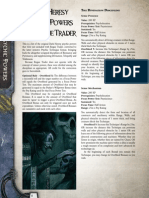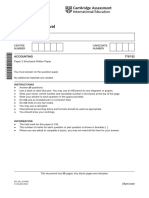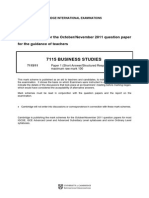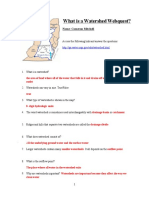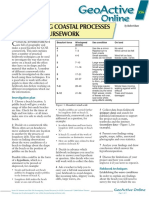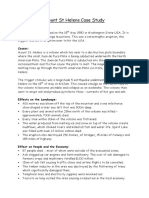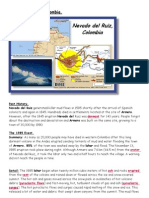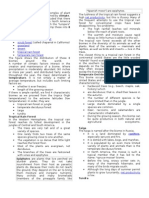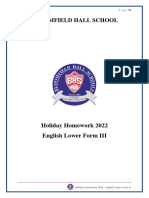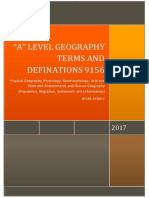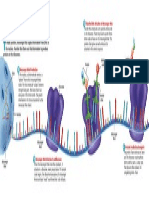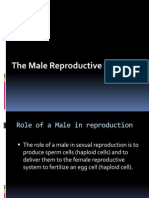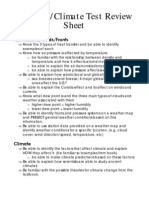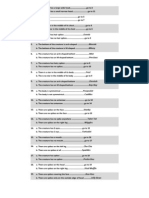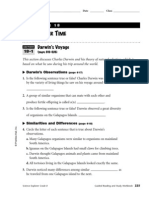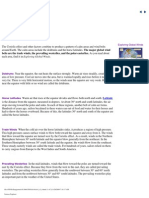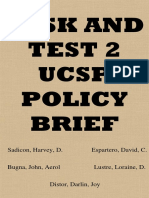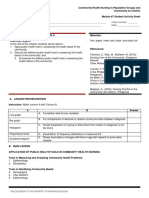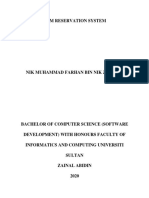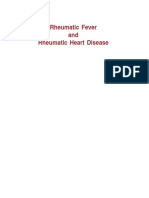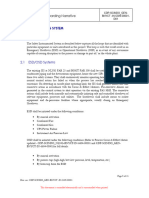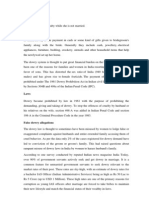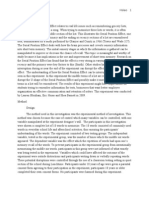Weathering and Erosion GN Review
Weathering and Erosion GN Review
Uploaded by
cmillica1176Copyright:
Available Formats
Weathering and Erosion GN Review
Weathering and Erosion GN Review
Uploaded by
cmillica1176Original Description:
Copyright
Available Formats
Share this document
Did you find this document useful?
Is this content inappropriate?
Copyright:
Available Formats
Weathering and Erosion GN Review
Weathering and Erosion GN Review
Uploaded by
cmillica1176Copyright:
Available Formats
Name ____________________________________ Date __________ Class ___________________
Name ____________________________________ Date __________ Class ___________________
CHAPTER 7 , Weathering and Soil Formation (continued)
CHAPTER 7
5. List the forces of mechanical weathering. a. d. 6. What is abrasion? b. e. c.
WEATHERING AND SOIL FORMATION
SECTION
Rocks and Weathering
(pages 226-231)
71
This section describes how rocks are broken down by forces of weathering. The section also describes factors that determine how quickly weathering occurs. The Effects of Weathering
Match the process with its description. Process 1. weathering 2. erosion Description a. Movement of rock particles by wind, water, ice, or gravity b. Breaking down of rock and other substances at Earths surface
(pages 226227)
7. Complete the cycle diagram.
Ice Wedging
Water seeps into cracks.
3. Complete the concept map.
Ice widens cracks.
Types of Weathering
Prentice-Hall, Inc.
Chemical Weathering
include
Prentice-Hall, Inc.
(pages 229230)
8. The process that breaks down rock through chemical changes is weathering. 9. List the agents of chemical weathering. a. d. b. e. c.
Mechanical Weathering
(pages 227228)
4. The type of weathering in which rock is physically broken into smaller pieces is called
Science Explorer Grade 7
10. Is the following sentence true or false? Chemical weathering produces rock particles with the same mineral makeup as the rock they came from.
weathering.
Guided Reading and Study Workbook
75
76
Guided Reading and Study Workbook
Science Explorer Grade 7
Name ____________________________________ Date __________ Class ___________________
Name ____________________________________ Date __________ Class ___________________
Match the agent of chemical weathering with the statement that is true about it. Agent 11. water 12. oxygen 13. carbon dioxide 14. living organisms 15. acid rain 16. Is the following sentence true or false? Water weathers rock by dissolving it. 17. Oxygen weathers rock through a process called 18. List two kinds of rock that are easily weathered by carbonic acid. a. 19. How do plants dissolve rock? b. . Statement a. It causes iron to rust. b. Its caused by pollution. c. Its the most important agent. d. It forms carbonic acid. e. Lichens are one example.
CHAPTER 7 , Weathering and Soil Formation (continued) 24. Why does chemical weathering occur more quickly in a hot climate?
SECTION
Soil Formation and Composition
(pages 235-241)
72
This section explains how soil forms. The section also describes several features of soil, the living things found in soil, and the types of soil found in the United States. Soil Formation
(page 235)
1. The loose, weathered material on Earths surface in which plants can grow is 2. How does soil form? .
Rate of Weathering
Prentice-Hall, Inc.
(page 231)
20. The most important factors that determine the rate of weathering are type of rock and .
3. The solid layer of rock beneath the soil is called
.
Prentice-Hall, Inc.
Soil Composition
(page 236)
21. Is the following sentence true or false? The minerals that make up a rock determine how fast it weathers. 22. A rock that is full of tiny, connected air spaces is said to be . 23. Why does a permeable rock weather chemically at a fast rate?
4. What two factors determine the type of rock particles and minerals in any given soil?
5. List the three types of weathered rock particles found in soil. a. b. c. .
6. The decayed organic material in soil is called
Science Explorer Grade 7
Guided Reading and Study Workbook
77
78
Guided Reading and Study Workbook
Science Explorer Grade 7
Name ____________________________________ Date __________ Class ___________________
Name ____________________________________ Date __________ Class ___________________
Soil Texture
(page 236)
CHAPTER 7 , Weathering and Soil Formation (continued)
7. Circle the letter of the choice that lists soil particles from largest to smallest. a. sand, gravel, clay, silt b. gravel, sand, silt, clay c. gravel, silt, sand, clay d. gravel, sand, clay, silt 8. Soil that is made up of about equal parts of clay, sand, and silt is called .
Rate of Soil Formation
(page 237)
13. Circle the letter of each sentence that is true about the rate of soil formation. a. It is faster in areas that are cold. b. It is slower in areas that are dry. c. It is faster with limestone than granite. d. It is unaffected by the type of rock being weathered.
Life in Soil
(pages 238240)
Soil Horizons
(page 237)
14. How do soil organisms improve soil?
Match the soil horizon with its makeup. Soil Horizon 9. A 10. B 11. C Makeup a. Topsoil b. Rock particles c. Subsoil 16. As plants shed leaves, they form a loose layer called 17. Soil organisms that turn dead organic matter into humus are called . 18. List the main soil decomposers.
Prentice-Hall, Inc.
15. Is the following sentence true or false? Animals contribute most of the organic remains that form humus. .
12. Label each of the soil horizons shown in the three drawings as A, B, or C horizon.
Surface
Prentice-Hall, Inc.
Surface
Surface
a.
b.
c.
d.
19. Circle the letter of each choice that is an example of fungi.
C Horizon
a. molds
C Horizon
b. mushrooms
c. bacteria
d. earthworms
20. Is the following sentence true or false? Earthworms do most of the work of mixing humus with other materials in soil.
C Horizon
21. How can burrowing mammals improve soil?
Bedrock
Bedrock
Bedrock
Science Explorer Grade 7
Guided Reading and Study Workbook
79
80
Guided Reading and Study Workbook
Science Explorer Grade 7
Name ____________________________________ Date __________ Class ___________________
Name ____________________________________ Date __________ Class ___________________
Soil Types in the United States
(pages 240241)
CHAPTER 7 , Weathering and Soil Formation (continued)
22. Circle the letter of each factor that scientists use to classify the different types of soil into groups. a. climate b. plant types c. soil composition d. size of animal populations 23. Is the following sentence true or false? The soil type of northeastern United States and Canada is southern forest soils.
The Value of Soil
(pages 243244)
3. Why is soil one of Earths most valuable resources?
4. Circle the letter of each sentence that is true about soil. a. Soil is a nonrenewable resource. b. Soil formation takes a long time. c. Fertile soil is plentiful. d. Half of Earth has soils good for farming
Reading Skill Practice
When you read a section that contains new or difficult material, identifying the sentence that best expresses the main topic under each heading can help you focus on the most important points. For each heading in Section 72, identify and copy the sentence that best expresses the main topic under that heading. Do your work on a separate sheet of paper.
5. List four reasons why farming is difficult in many areas on Earth. a. b. c. d.
Soil Damage and Loss
SECTION
(page 244)
Soil Conservation
(pages 243-246)
6. How can soil be damaged?
Prentice-Hall, Inc.
Prentice-Hall, Inc.
73
This section explains why soil is valuable. The section also explains how soil can be damaged or lost, as well as how it can be conserved. Introduction
(pages 243)
7. How can soil be lost?
8. Parts of Oklahoma and surrounding states that lost soil in the 1930s were called the .
(page 244)
1. The thick mass of tough roots at the surface of the soil is called . 2. Prairie soils are among the most world. soils in the
The Dust Bowl
9. As you go from east to west across the Great Plains, the amount of rainfall steadily.
Science Explorer Grade 7
Guided Reading and Study Workbook
81
82
Guided Reading and Study Workbook
Science Explorer Grade 7
Name ____________________________________ Date __________ Class ___________________
Name ____________________________________ Date __________ Class ___________________
10. Why did the Dust Bowl occur?
CHAPTER 7 , Weathering and Soil Formation (continued)
WordWise
Test your knowledge of key terms from Chapter 7 by solving the clues. Then copy the numbered letters in order to reveal the hidden message. 11. The soil lost from the Dust Bowl ended up in the Ocean. 12. In the southern Plains states, the drought and topsoil loss lasted until Solid layer of rock beneath soil .
3 4
Clues Process of moving fragments of rock and soil
Key Terms
1 2
Soil Conservation
Thick mass of grass roots and soil
(page 246)
13. The management of soil to prevent its destruction is referred to as . 14. Complete the concept map.
Ways to conserve soil
Grinding away of rock by rock particles
6
Loose layer of dead plant material on the soil surface Organisms that break down wastes and dead organisms Organic material in soil
10 8
7 9
include
Processes that break down rock at Earths surface
11
Topmost layer of soil
12
Prentice-Hall, Inc.
Soil with about equal parts of clay, sand, and silt
13
Prentice-Hall, Inc.
Layer of soil beneath the topsoil
14
15. The practice of plowing fields along the curve of a slope is called . 16. A method of farming that disturbs the soil and its plant cover as little as possible is called .
Loose, weathered material in which plants can grow Hidden Message
15
.
1 2 3 4 5 6 7 8 9 10 11 12 13 14 15
Science Explorer Grade 7
Guided Reading and Study Workbook
83
84
Guided Reading and Study Workbook
Science Explorer Grade 7
Name ____________________________________ Date __________ Class ___________________
Name ____________________________________ Date __________ Class ___________________
CHAPTER 8 , Erosion and Deposition (continued)
CHAPTER 8
6. Is the following sentence true or false? The most destructive kind of mass movement is creep. 7. Is the following sentence true or false? Mudflows and slump are especially likely in soils high in clay. 8. Complete the concept map.
Mass movement
EROSION AND DEPOSITION
SECTION
Changing Earths Surface
(pages 252-255)
81
This section explains how sediment is carried away and deposited elsewhere to wear down and build up Earths surface. The section also describes ways that gravity moves sediment downhill. Wearing Down and Building Up
1. What is erosion?
(page 253) Landslides
includes
Match the type of mass movement with its description. 2. List the forces that cause erosion. a. d. b. e. . c. Mass Movement 9. landslide 10. mudflow 11. slump 12. creep Description a. Rock and soil suddenly slip down a slope in one large mass. b. Rock and soil slide quickly down a slope. c. Rock and soil move very slowly downhill. d. A mixture of water, rock, and soil moves rapidly downhill.
Prentice-Hall, Inc.
3. The material moved by erosion is called
Prentice-Hall, Inc.
4. Where does deposition occur?
Mass Movement
(pages 253255)
Reading Skill Practice
When reading about cyclical processes, making a cycle diagram can help you understand how the processes are related. As you read or review Section 8-1, make a cycle diagram showing how the processes of weathering, erosion, and deposition are related. For more information on cycle diagrams, see page 661 in the Skills Handbook of the textbook. Do your work on a separate sheet of paper.
5. Circle the letter of each sentence that is true about gravity. a. It pulls things toward Earths center. b. It causes landslides. c. It causes mass movement. d. It is a force of erosion.
Science Explorer Grade 7 Guided Reading and Study Workbook
85
86 Guided Reading and Study Workbook
Science Explorer Grade 7
Name ____________________________________ Date __________ Class ___________________
Name ____________________________________ Date __________ Class ___________________
SECTION
Water Erosion
(pages 258-267)
CHAPTER 8 , Erosion and Deposition (continued) 7. The area of land from which a river and its tributaries collect water is the .
82
This section describes how moving water erodes and deposits sediment to create landforms such as valleys and deltas. Runoff and Erosion
(pages 259260)
8. Is the following sentence true or false? The high ground between two drainage basins is called a divide.
1. Is the following sentence true or false? Moving water is the major agent of erosion. 2. Water that moves over Earths surface when it rains is called . 3. Fill in the first column of the table with the correct form of moving water.
Forms of Moving Water Form Description
Tiny groove in soil formed by runoff Channel that carries runoff after a rainstorm Channel with water continually flowing down a slope Large stream
Prentice-Hall, Inc.
Erosion by Rivers
(pages 261262)
9. How do V-shaped valleys form?
10. When does a river develop meanders?
11. A meander that has been cut off from a river is called a(n) . 12. Identify and label each of the following landforms in the illustration: waterfall, oxbow lake, meander, flood plain, and V-shaped valley.
Prentice-Hall, Inc.
4. Other than how people use the land, list four factors that determine the amount of runoff in an area. a. c. b. d.
Meander
Waterfall V-shaped valley
5. Is the following sentence true or false? More runoff generally means less erosion.
Flood plain
River Systems
(pages 260261)
Oxbow lake
6. A stream that flows into a larger stream is called a(n)
Science Explorer Grade 7
.
Guided Reading and Study Workbook
87
88 Guided Reading and Study Workbook
Science Explorer Grade 7
Name ____________________________________ Date __________ Class ___________________
Name ____________________________________ Date __________ Class ___________________
Deposits by Rivers
(pages 263265)
CHAPTER 8 , Erosion and Deposition (continued)
SECTION
13. List two landforms created from deposits by rivers. a. 14. What is an alluvial fan? b.
The Force of Moving Water
(pages 271-274)
83
This section explains why moving water has energy and how it erodes and carries sediment. The section also identifies the factors that determine how much sediment a river can erode and carry. Work and Energy
(pages 271272)
15. Sediments deposited where a river flows into an ocean or lake form a(n) .
1. The ability to do work or cause change is 2. Energy that is stored for later use is called
. energy.
16. What makes a river valley fertile?
3. Is the following statement true or false? Kinetic energy is the energy an
Groundwater Erosion and Deposition
17. Underground water is called .
(pages 266267)
object has due to its motion.
How Water Erodes and Carries Sediment
4. In what ways can sediment enter a river?
(page 272)
18. Is the following sentence true or false? Unlike moving surface water, groundwater does not cause erosion. 19. How does groundwater cause chemical weathering of limestone?
5. The wearing away of rock by a grinding action is called
Prentice-Hall, Inc. Prentice-Hall, Inc.
20. Complete the compare/contrast table.
Groundwater Deposits In Limestone Caves Type of Deposit Where It Forms
Roof of cave Floor of cave
. 6. Is the following sentence true or false? Sediment in a river abrades the streambed and is abraded by the streambed in return. 7. The amount of sediment that a river carries is its 8. Circle the letter of each sentence that is true about a rivers sediment. a. Gravity and the force of the water cause sediment to move downstream. b. Most small sediments move by rolling and sliding along the bottom. c. Most large sediments move by bouncing. d. Some sediments are dissolved by the water and carried in solution. .
21. Is the following sentence true or false? An area where sinkholes are common is said to have karst topography.
Science Explorer Grade 7
Guided Reading and Study Workbook
89
90 Guided Reading and Study Workbook
Science Explorer Grade 7
Name ____________________________________ Date __________ Class ___________________
Name ____________________________________ Date __________ Class ___________________
Erosion and Sediment Load
9. Complete the concept map.
(pages 273274)
CHAPTER 8 , Erosion and Deposition (continued) 17. Label the drawing to show where the river erodes sediment and where it deposits sediment as it flows around the curve.
A rivers power to erode
depends on
10. Is the following sentence true or false? When a river slows down and deposits its sediment load, smaller particles of sediment are deposited
SECTION
first. 11. Circle the letter of each factor that increases the speed of a river. a. Steep slope c. Deep streambed b. Low volume d. Boulders in streambed
Glaciers
(pages 275-279)
84
This section describes huge ice masses, called glaciers. The section also describes the ice ages, a time when glaciers covered much of Earth. In addition, the section explains how glaciers form and move and how they cause erosion and deposition. Kinds of Glaciers
(pages 275276)
12. Circle the letter of each factor that decreases the speed of a river. a. Gentle slope c. Shallow streambed Match the term with its definition.
Prentice-Hall, Inc.
b. High volume d. Boulders in streambed
1. Any large mass of ice that moves slowly over land is a(n) .
Prentice-Hall, Inc.
Term 13. flow 14. friction 15. turbulence
Definition a. Movement of water every which way instead of downstream b. Force that opposes the motion of one surface across another c. Volume of water that moves past a point on a river in a given time
2. Circle the letter of each sentence that is true about valley glaciers. a. They are long, narrow glaciers. b. They are found on many high mountains. c. They are larger than continental glaciers. d. They follow river valleys. 3. Circle the letter of each sentence that is true about continental glaciers. a. They are larger than valley glaciers. b. They spread out over wide areas. c. They are found only in Antarctica. d. They cover 2 percent of Earths land.
16. Is the following sentence true or false? Where a river flows in a straight line, the water flows faster along the rivers sides than near the center.
Science Explorer Grade 7
Guided Reading and Study Workbook
91
92 Guided Reading and Study Workbook
Science Explorer Grade 7
Name ____________________________________ Date __________ Class ___________________
Name ____________________________________ Date __________ Class ___________________
Ice Ages
(page 276)
CHAPTER 8 , Erosion and Deposition (continued) 12. Describe the process of abrasion by a glacier and the effect abrasion has on the bedrock.
4. What are ice ages?
5. Is the following sentence true or false? The most recent ice age ended about 10,000 years ago. 6. Is the following sentence true or false? All of North America was covered by a continental glacier in the last ice age.
Glacial Deposition
(pages 277279)
13. When does a glacier deposit the sediment it is carrying?
How Glaciers Form and Move
7. Where can glaciers form?
(page 276)
Match each type of glacial landform with its description. Landform Description a. Small depression formed by a chunk of ice and filled with water b. Mixture of sediments a glacier deposits on the surface c. Ridge formed at the edge of a glacier d. Shallow depression formed by flowing water e. Ridge at the farthest point reached by a glacier f. Sharp ridge separating two cirques g. Bowl-shape hollow eroded by a glacier h. Sea-filled valley cut by a glacier in a coastal region 22. How were the Great Lakes formed?
Prentice-Hall, Inc.
8. When does gravity begin to pull a glacier downhill?
14. till 15. moraine 16. terminal moraine
9. Complete the table.
How Glaciers Move Type of Glacier
Prentice-Hall, Inc.
17. prairie pothole 18. kettle 19. cirque 20. arte 21. fiord
How It Moves
Flows in all directions Flows in a surge
Glacial Erosion
(pages 276277)
10. List two processes by which glaciers erode the land. a. b.
11. Is the following sentence true or false? Plucking can move only small stones.
Science Explorer Grade 7
Guided Reading and Study Workbook
93
94 Guided Reading and Study Workbook
Science Explorer Grade 7
Name ____________________________________ Date __________ Class ___________________
Name ____________________________________ Date __________ Class ___________________
SECTION
Waves and Wind
(pages 280-285)
CHAPTER 8 , Erosion and Deposition (continued)
85
Landforms Created by Wave Erosion
7. List three landforms created by wave erosion.
(page 282)
This section explains how waves form. The section also describes the erosion and deposition that waves and wind cause. How Waves Form
a. It comes from wind. b. It moves water particles up and down. c. It moves water particles forward. d. It moves across the water.
(pages 280281)
a.
b.
(pages 282283)
c.
Deposits by Waves
1. Circle the letter of each sentence that is true about the energy in waves.
8. An area of wave-washed sediment along a coast is a(n) . 9. The process in which beach sediment is moved down the beach with the current is called 10. How does a spit form? .
2. What part of the water is affected by a wave in deep water?
11. How is a barrier beach formed? 3. Circle the letter of each sentence that is true about a wave approaching land. a. It begins to drag on the bottom. b. It encounters more friction. c. It speeds up.
Prentice-Hall, Inc.
12. Is the following sentence true or false? Storm winds can wash away barrier beaches.
Prentice-Hall, Inc.
d. It moves the water toward the land.
Erosion by Waves
How Wind Causes Erosion
(page 281)
(pages 283284)
4. Is the following sentence true or false? Waves are the major force of erosion along coasts. 5. List two ways that waves erode land. a. b.
13. A deposit of wind-blown sand is a(n)
14. Is the following sentence true or false? Wind alone is the strongest agent of erosion. 15. Why is wind very effective at causing erosion in deserts?
6. Part of the shore that sticks out into the ocean because it is made of harder rock is called a(n) .
Science Explorer Grade 7
Guided Reading and Study Workbook
95
96 Guided Reading and Study Workbook
Science Explorer Grade 7
Name ____________________________________ Date __________ Class ___________________
Name ____________________________________ Date __________ Class ___________________
4. Circle the letter of each sentence that is true about deflation. a. It is the main way wind causes erosion. b. It usually has a great effect on the land. c. It can create blowouts. d. It can create desert pavement. 5. Circle the letter of each sentence that is true about abrasion. a. It can polish rock. b. It is caused by wind-carried sand. c. It causes most desert landforms. d. It causes most erosion.
CHAPTER 8 , Erosion and Deposition (continued)
SECTION
Earth Systems and Catastrophic Events
(pages 286-290)
86
This section describes natural hazards and explains how human activities can increase the effects of natural hazards. Natural Hazards and Catastrophic Events
1. What is a natural hazard?
(page 287)
Deposits Resulting From Wind Erosion
2. List six examples of natural hazards.
(page 285)
6. Is the following sentence true or false? All the sediment picked up by wind eventually falls to the ground. 7. When does wind-carried sediment fall to the ground?
a. d.
b. e.
c. f.
3. Is the following sentence true or false? Natural hazards care the result of processes that take place in Earth systems. 4. Why are hurricanes and earthquakes natural hazards?
8. List two types of deposits formed by wind erosion and deposition. a.
Prentice-Hall, Inc.
b.
Prentice-Hall, Inc.
9. Complete the Venn diagram by adding the following phrases: have finer sediments, have coarser sediments, result from wind erosion.
Sand Dunes Loess Deposits
Impact on Earth
(pages 288-289)
5. Compete the concept map.
Catastrophic events
result from processes
Science Explorer Grade 7
Guided Reading and Study Workbook
97
98 Guided Reading and Study Workbook
Science Explorer Grade 7
Name ____________________________________ Date __________ Class ___________________
Name ____________________________________ Date __________ Class ___________________
6. Describe two ways catastrophic events can change Earths crust.
CHAPTER 8 , Erosion and Deposition (continued)
WordWise
Use the clues to help you unscramble the key terms from Chapter 8. Then put the numbered letters in the right order to spell out the answer to the riddle.
Human Activities
Clues
(pages 289290)
Key Terms sorineo
1 2
Its how sediment moves. Its how sediment settles. Its a small particle that moves. oisontipde
7. Is the following sentence true or false? Where people locate their activities can increase the damaging effects of natural hazards.
ideemtns
4 5
8. Complete the flowchart to show how land use affects the impact of a natural hazard.
Forests on slopes hold soil in place and absorb .
Its how much sediment a river carries. Its the force that opposes motion of one surface across another. Its how rocks are polished. It can be found where a river enters a lake. It separates two drainage basins. nfcotiri
adol
6 7
barinoas
8 9
People clear forests for
and
ldtae
10
vdeiid
11
Soil is not protected from
Its formed by a chunk of ice. It sticks out in the water like a finger.
teketl
12
ipst
13
Hurricanes bring heavy
Prentice-Hall, Inc.
Its a ridge at the edge of a glacier. Its a deposit of clay and silt.
noamire
14
Prentice-Hall, Inc.
seols
15
Runoff loosens the
and mud flows into river valleys.
Its how most wind erosion occurs. It flows into a larger stream.
otefdalni
16
tutyrabir
17 18
9. Why is building a home on a flood plain risky?
Its a kind of lake created by a river. Its the ability to do work or cause change. Riddle: What shapes Earths surface? Answer:
1 2 3 4 5 6 7 8 9 10
wxoob
19
10. What is a tsunami?
ynreeg
20
11 12 13 14 15 16 17 18 19 20
Science Explorer Grade 7
Science Explorer Grade 7
Guided Reading and Study Workbook
99
100 Guided Reading and Study Workbook
You might also like
- Rogue Trader - Converted Dark Heresy Psychic PowersDocument13 pagesRogue Trader - Converted Dark Heresy Psychic PowersDontNeed100% (3)
- Drains To Living Streams WORKBOOK Bodkin Park 2022 (003) - 1Document32 pagesDrains To Living Streams WORKBOOK Bodkin Park 2022 (003) - 1sponNo ratings yet
- Dichotomous Key Activity MonstersDocument3 pagesDichotomous Key Activity Monsterscmillica1176100% (2)
- 83 Storm HydrographDocument4 pages83 Storm HydrographSulaiman Musa MuhammadNo ratings yet
- Flooding in YorkDocument24 pagesFlooding in Yorksuejacksonthree100% (26)
- Dichotomous Keys WorksheetDocument1 pageDichotomous Keys Worksheetcmillica11760% (1)
- Year 9 Geography: Tectonic HazardsDocument39 pagesYear 9 Geography: Tectonic HazardsfggyNo ratings yet
- NEA - How Does Human Impact Affect Sand Dune Succession at Jebel Ali and Black Palace Beach (AutoRecovered)Document27 pagesNEA - How Does Human Impact Affect Sand Dune Succession at Jebel Ali and Black Palace Beach (AutoRecovered)Lara ElliottNo ratings yet
- What Is The Difference Between Weathering and Erosion?Document21 pagesWhat Is The Difference Between Weathering and Erosion?xenonxavier11No ratings yet
- Cambridge O Level: Business Studies 7115/11 October/November 2020Document20 pagesCambridge O Level: Business Studies 7115/11 October/November 2020r3za_5008No ratings yet
- World Food Outlook: Geo FactsheetDocument4 pagesWorld Food Outlook: Geo FactsheetParco300No ratings yet
- Method StatementDocument3 pagesMethod Statementreborn_willyNo ratings yet
- American Block Swivels Model A-200Document20 pagesAmerican Block Swivels Model A-200aldino020203100% (3)
- Weathering and Erosion 2013Document114 pagesWeathering and Erosion 2013cmillica1176100% (1)
- Cambridge O Level: ACCOUNTING 7707/22Document20 pagesCambridge O Level: ACCOUNTING 7707/22saifuddinahmed856No ratings yet
- Cambridge O Level: ACCOUNTING 7707/22Document20 pagesCambridge O Level: ACCOUNTING 7707/22shujaitbukhariNo ratings yet
- University of Cambridge International Examinations General Certificate of Education Ordinary LevelDocument4 pagesUniversity of Cambridge International Examinations General Certificate of Education Ordinary Levelmstudy123456No ratings yet
- 0450 7115 QP 1Document1,548 pages0450 7115 QP 1ShakhnozaNo ratings yet
- Cambridge O Level: 7115/11 Business StudiesDocument12 pagesCambridge O Level: 7115/11 Business Studiesr3za_5008No ratings yet
- Cambridge O Level: ACCOUNTING 7707/23Document20 pagesCambridge O Level: ACCOUNTING 7707/23AB YUNo ratings yet
- Cambridge O Level: 7115/21 Business StudiesDocument12 pagesCambridge O Level: 7115/21 Business Studiesr3za_5008No ratings yet
- Cambridge O Level: 7115/12 Business StudiesDocument12 pagesCambridge O Level: 7115/12 Business Studiesnajla nistharNo ratings yet
- 7115 w12 QP 11Document12 pages7115 w12 QP 11mstudy123456No ratings yet
- 7115 - s18 - in - 22 Business StudiesDocument4 pages7115 - s18 - in - 22 Business StudiesMano_Bili89No ratings yet
- University of Cambridge International Examinations General Certificate of Education Ordinary LevelDocument12 pagesUniversity of Cambridge International Examinations General Certificate of Education Ordinary LevelSyed Muneeb AbidNo ratings yet
- 7115 Business Studies: MARK SCHEME For The October/November 2011 Question Paper For The Guidance of TeachersDocument10 pages7115 Business Studies: MARK SCHEME For The October/November 2011 Question Paper For The Guidance of Teachersmstudy123456No ratings yet
- Cambridge O Level: Business Studies 7115/11 May/June 2021Document21 pagesCambridge O Level: Business Studies 7115/11 May/June 2021nayna sharminNo ratings yet
- Cambridge O Level: 7115/11 Business StudiesDocument12 pagesCambridge O Level: 7115/11 Business StudiesYehiaNo ratings yet
- Cambridge O Level: 7115/12 Business StudiesDocument12 pagesCambridge O Level: 7115/12 Business Studiesr3za_5008No ratings yet
- GCSE Rivers River Landforms FormationDocument48 pagesGCSE Rivers River Landforms FormationWill TeeceNo ratings yet
- Watersheds and River Basin WebquestDocument3 pagesWatersheds and River Basin Webquestapi-330464848100% (1)
- 7115 s09 QP 2Document12 pages7115 s09 QP 2mstudy123456No ratings yet
- Cambridge O Level: Business Studies 7115/12 October/November 2020Document21 pagesCambridge O Level: Business Studies 7115/12 October/November 2020r3za_5008No ratings yet
- Business Studies - Exam Paper 1Document12 pagesBusiness Studies - Exam Paper 1Azar100% (1)
- Cambridge O Level: Accounting 7707/12Document12 pagesCambridge O Level: Accounting 7707/12shujaitbukhariNo ratings yet
- Coastal FieldworkDocument4 pagesCoastal FieldworkebidNo ratings yet
- Cambridge O Level: 7115/21 Business StudiesDocument12 pagesCambridge O Level: 7115/21 Business StudiesfallonNo ratings yet
- Cambridge O Level: ACCOUNTING 7707/22Document16 pagesCambridge O Level: ACCOUNTING 7707/22Syeda Malika AnjumNo ratings yet
- Theme 1 - Rivers and Coasts Revision NotesDocument26 pagesTheme 1 - Rivers and Coasts Revision NotesZantaye ThomasNo ratings yet
- Cambridge O Level: Accounting 7707/12Document12 pagesCambridge O Level: Accounting 7707/12Fred SaneNo ratings yet
- Cambridge O Level: 7115/11 Business StudiesDocument12 pagesCambridge O Level: 7115/11 Business StudiesDeshanNo ratings yet
- Worksheet Biosphere (KEY)Document7 pagesWorksheet Biosphere (KEY)rkvNo ratings yet
- Chapter 6 Managing Natural Hazards-1Document6 pagesChapter 6 Managing Natural Hazards-1eithar1sidigNo ratings yet
- Physical Geography Case Study RevisionDocument17 pagesPhysical Geography Case Study Revisionapi-336814146No ratings yet
- GEOGRAPHY A LEVEL (FORM SIX) NOTES - PHYSICAL GEOGRAPHY 1.5 - STUDY OF SOIL - EcoleBooksDocument63 pagesGEOGRAPHY A LEVEL (FORM SIX) NOTES - PHYSICAL GEOGRAPHY 1.5 - STUDY OF SOIL - EcoleBooksMukasa NajibNo ratings yet
- Paper 4 Enquiry SkillsDocument40 pagesPaper 4 Enquiry SkillsYixuan Jiang100% (1)
- Cambridge O Level: 7115/22 Business StudiesDocument4 pagesCambridge O Level: 7115/22 Business Studiesnayna sharmin0% (1)
- Exam Practice AnswersDocument41 pagesExam Practice Answershweta173No ratings yet
- Weathering. Form 1-4 Notes Compiled by MR K. Romo 0772858765Document16 pagesWeathering. Form 1-4 Notes Compiled by MR K. Romo 0772858765Sharon MasikiNo ratings yet
- Fold Mountain Revision SheetDocument4 pagesFold Mountain Revision Sheetapi-488871493No ratings yet
- IGCSE Geography - Worksheet 12.2Document1 pageIGCSE Geography - Worksheet 12.2SangkasNo ratings yet
- Mount St. Helens Case Study NotesDocument3 pagesMount St. Helens Case Study Notesfaryal khanNo ratings yet
- Nevado Del Ruiz Case StudyDocument4 pagesNevado Del Ruiz Case Study3alliumcourtNo ratings yet
- GCSE Rivers Revision - The Lower CourseDocument2 pagesGCSE Rivers Revision - The Lower CoursecwnoraniNo ratings yet
- Perfect Storm FCE WorksheetDocument10 pagesPerfect Storm FCE Worksheetpaula740003No ratings yet
- Case Study Holderness CoastlineDocument1 pageCase Study Holderness Coastlinebiology111No ratings yet
- BiomesDocument9 pagesBiomesapi-26570979100% (1)
- 8.4 How Is The Physical Landscape of Hong Kong Shaped by External Processes StudentDocument36 pages8.4 How Is The Physical Landscape of Hong Kong Shaped by External Processes Students200196No ratings yet
- Environmental Summary CH 5Document4 pagesEnvironmental Summary CH 5estefaniaelizabethdiaz0100% (1)
- Constructing Climate GraphDocument19 pagesConstructing Climate Graphapi-220646053No ratings yet
- The 3 Gorges DamDocument4 pagesThe 3 Gorges Damapi-361310234No ratings yet
- English Lower Form IIIDocument13 pagesEnglish Lower Form IIIMuhammad Shafay QureshiNo ratings yet
- "A" Level Geography Terms and Definations 9156Document48 pages"A" Level Geography Terms and Definations 9156KudakwasheNo ratings yet
- Soil Formation WorksheetDocument4 pagesSoil Formation WorksheetNina AzizNo ratings yet
- Science Summative Test No. 1Document2 pagesScience Summative Test No. 1Ronalyn RequizoNo ratings yet
- Meiosis MYPDocument14 pagesMeiosis MYPcmillica1176No ratings yet
- Protein Synthesis DiagramDocument1 pageProtein Synthesis Diagramcmillica1176No ratings yet
- Mitosis Vs MeiosisDocument40 pagesMitosis Vs Meiosiscmillica1176No ratings yet
- Atoms, Electrons & Energy Levels: Electrons Are The Bonds That Hold The World Together!Document41 pagesAtoms, Electrons & Energy Levels: Electrons Are The Bonds That Hold The World Together!cmillica1176100% (3)
- Characteristics of StarsDocument15 pagesCharacteristics of Starscmillica1176No ratings yet
- What You Need To Know For The GeneticsDocument15 pagesWhat You Need To Know For The Geneticscmillica1176No ratings yet
- The Reproductive SystemDocument18 pagesThe Reproductive Systemcmillica1176No ratings yet
- Weather Climate Review SheetDocument1 pageWeather Climate Review Sheetcmillica1176No ratings yet
- DNA, RNA & Protein SynthesisDocument21 pagesDNA, RNA & Protein Synthesiscmillica1176100% (4)
- Weather Systems: in This Presentation You Will: Explore The Impact of The Sun's Energy On Earth's Weather SystemsDocument52 pagesWeather Systems: in This Presentation You Will: Explore The Impact of The Sun's Energy On Earth's Weather Systemscmillica1176100% (1)
- Excretory SystemDocument11 pagesExcretory Systemcmillica1176100% (2)
- Ecological SuccessionDocument16 pagesEcological Successioncmillica1176No ratings yet
- Endocrine SystemDocument28 pagesEndocrine Systemcmillica1176100% (1)
- Lab Report BasicsDocument2 pagesLab Report Basicscmillica1176No ratings yet
- Alien Pets Dichotomous Key ActivityDocument2 pagesAlien Pets Dichotomous Key Activitycmillica1176No ratings yet
- Weather Maps and Intro To ClimateDocument39 pagesWeather Maps and Intro To Climatecmillica1176No ratings yet
- Natural Selection Guided NotesDocument4 pagesNatural Selection Guided Notescmillica1176No ratings yet
- Metric Conversion HWDocument2 pagesMetric Conversion HWcmillica1176No ratings yet
- Cluster 7B Open House 2011Document28 pagesCluster 7B Open House 2011cmillica1176No ratings yet
- Global Wind ReadingDocument2 pagesGlobal Wind Readingcmillica1176No ratings yet
- EVB Series: End-Of-Line Deflagration Flame ArrestersDocument2 pagesEVB Series: End-Of-Line Deflagration Flame Arresterstienhm_pve1553No ratings yet
- Policy BriefDocument3 pagesPolicy BriefDAVID EsparteroNo ratings yet
- Promotion and TransferDocument39 pagesPromotion and TransferTHOUFEEK100% (1)
- Pre Qualification QuestionnaireDocument15 pagesPre Qualification Questionnairezafarmb100% (1)
- Hypertension: Apurva Shrestha AamppipalDocument15 pagesHypertension: Apurva Shrestha AamppipalApurvaNo ratings yet
- CHN 2 Session 7 SASDocument9 pagesCHN 2 Session 7 SASrica sebabillonesNo ratings yet
- (Degree Thesis) GYM RESERVATION SYSTEMDocument67 pages(Degree Thesis) GYM RESERVATION SYSTEMLiu YuXinNo ratings yet
- Rheumatic Fever and Rheumatic Heart Disease PDFDocument178 pagesRheumatic Fever and Rheumatic Heart Disease PDFFian AldyNo ratings yet
- Dorothea OremDocument45 pagesDorothea OremSarika YadavNo ratings yet
- Features General Description: Bc2302A/Bc2302B Sub-1Ghz Low-If Ook RF ReceiverDocument14 pagesFeatures General Description: Bc2302A/Bc2302B Sub-1Ghz Low-If Ook RF ReceiverOne SpringNo ratings yet
- The History of MatchesDocument9 pagesThe History of MatchesMarjorie España - CamachoNo ratings yet
- CDP-SCINDO - GEN-BNYCT-IN-5309-0001-D01-Safeguarding Narrative 9Document1 pageCDP-SCINDO - GEN-BNYCT-IN-5309-0001-D01-Safeguarding Narrative 9ELDENo ratings yet
- Water Quality Assessment in Qu River Based On Fuzzy Water Pollution Index Method 2016 Journal of Environmental SciencesDocument7 pagesWater Quality Assessment in Qu River Based On Fuzzy Water Pollution Index Method 2016 Journal of Environmental SciencespelangilaksmitaNo ratings yet
- Business Plan1Document18 pagesBusiness Plan1Jessan Balasangay50% (2)
- 전기자재 전원사양Document4 pages전기자재 전원사양최경현No ratings yet
- Pressofiltro Nutsche Filter / Filter DryerDocument2 pagesPressofiltro Nutsche Filter / Filter Dryerviajes cdcNo ratings yet
- Unmarried Mothe1Document3 pagesUnmarried Mothe1subbu2raj3372No ratings yet
- 201 enDocument2 pages201 enRyan ZhangNo ratings yet
- Biology Chapter 2Document17 pagesBiology Chapter 2Matthew LiddellNo ratings yet
- Psych IADocument10 pagesPsych IAs4_ithead100% (1)
- Final AVN Response To The HCCCDocument66 pagesFinal AVN Response To The HCCCMeryl DoreyNo ratings yet
- Test Bahasa Inggris2Document7 pagesTest Bahasa Inggris2SuhardiWinaryoNo ratings yet
- Preventive KompresorDocument13 pagesPreventive KompresorSatria PradanaNo ratings yet
- Guide To Batteries Ur: 3rd EditionDocument28 pagesGuide To Batteries Ur: 3rd EditionAliNo ratings yet
- Usha RangarajanDocument85 pagesUsha Rangarajansalinashaikh194No ratings yet
- Earthing and Bonding: in Hazardous LocationsDocument3 pagesEarthing and Bonding: in Hazardous LocationsTony Caroline MorganNo ratings yet
- Ic01 2Document26 pagesIc01 2Htet Lynn HtunNo ratings yet
